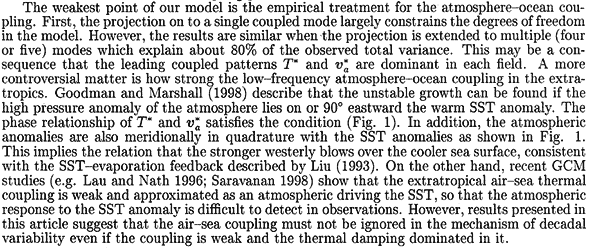On the other hand, the thermal coupling largely suppresses the variance at lower frequencies including decadal/interdecadal band, as can be inferred from the spectra of the T-coupled cases. Thus the power spectra shownin Fig. 5 indicate the apparent, but different role of the dynamical and thermodynamic coupling; the dynamical coupling amplifies the decadal peak while the thermal coupling suppresses the variance at lower frequencies. The distinct decadal spectral peaks in the fully-coupled system is a consequence of those two coupling effects. The above results do not change even when the coupling condition is stable, .i.e., no positive wind feedback in Eq. (5).
SUMMARY AND DISCUSSION
A simple atmosphere-ocean model which adopts an empirical relationship between SST and overlying wind anomalies was developed to investigate the behavior of decadal variations in the North Atlantic and the North Pacific, especially their dependence on oceanic and coupling processes. Although the model is simple, the numerical solution with realistic values of parameters shows continuous oscillations which resemble the observations both in period and in spatial features. In the model, the oscillatory mode gains energy through the positive feedback between the atmosphere and the ocean, while the phase transition results from the slow ocean advection which can be divided into two processes: the advection by the anomalous current related to the oceanic Rossby wave and the advection by the mean gyre. Lagged feedback in the standard experiments is attributed both to the Rossby wave dynamics and the mean advection. However, sensitivity experiments indicate that the one of the above two advective processes is often possible to produce the decadal oscillation.
The influence of the stochastic weather noise to the decadal oscillation was explored. In both oceans, the atmospheric noise with enough magnitude increases the variance of oscillation, which may partly explain the observed decadal variance. When the temperature field is forced by the noise without coupled components, the power spectrum is similar to the red noise spectrum consistent with the stochastic theory. The coupled atmospheric anomalies, even if they are much smaller than the noise, generate a distinct decadal spectral peak, indicating the significant contribution of the coupling process to the decadal oscillation.

REFERENCES
Barsugli, J. J. and D. S. Battisti, 1998: The basic effects of atmosphere-ocean thermal couling on midlatitude variability. J. Atmos.Sci., 55, 477-493.
Deser, C. and M. Blackmon, 1993: Surface climate variations over the North Atlantic ocean during winter: 1900-1989. J. Climate, 6, 1743-1753.